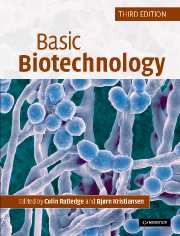Book contents
- Frontmatter
- Contents
- List of contributors
- Preface to the second edition
- Preface to the third edition
- Part I Fundamentals and principles
- Chapter 1 Public perception of biotechnology
- Chapter 2 Biochemistry and physiology of growth and metabolism
- Chapter 3 Stoichiometry and kinetics of microbial growth from a thermodynamic perspective
- Chapter 4 Genome management and analysis: prokaryotes
- Chapter 5 Genetic engineering: yeasts and filamentous fungi
- Chapter 6 Microbial process kinetics
- Chapter 7 Bioreactor design
- Chapter 8 Mass transfer
- Chapter 9 Downstream processing
- Chapter 10 Measurement, monitoring, modelling and control
- Chapter 11 Process economics
- Part II Practical applications
- Index
Chapter 1 - Public perception of biotechnology
Published online by Cambridge University Press: 05 June 2012
- Frontmatter
- Contents
- List of contributors
- Preface to the second edition
- Preface to the third edition
- Part I Fundamentals and principles
- Chapter 1 Public perception of biotechnology
- Chapter 2 Biochemistry and physiology of growth and metabolism
- Chapter 3 Stoichiometry and kinetics of microbial growth from a thermodynamic perspective
- Chapter 4 Genome management and analysis: prokaryotes
- Chapter 5 Genetic engineering: yeasts and filamentous fungi
- Chapter 6 Microbial process kinetics
- Chapter 7 Bioreactor design
- Chapter 8 Mass transfer
- Chapter 9 Downstream processing
- Chapter 10 Measurement, monitoring, modelling and control
- Chapter 11 Process economics
- Part II Practical applications
- Index
Summary
Introduction
Public perception of new technologies can have pronounced effects on the timing and direction of innovation, and on rates of uptake or discrimination of the technology, its products and services. Public perception can be area- or region-specific (e.g. North America, Southeast Asia, etc.) and will be dependent on several variables, namely
economic affluence,
level of education,
cultural and religious values and traditions, and
social and institutional ways of participation.
At the present time, public perception of biotechnology is generating much debate, especially in the EU.
Before entering into an examination of how the general public are believed to perceive modern biotechnology, especially genomics and proteomics, it is pertinent to highlight how biotechnology evolved historically to its present-day profound and positive impact on industry, medicine, agriculture, commerce and the environment. Historically, the microbial aspects of biotechnology evolved over many centuries as an artisan skill rather than as a science exemplified in the ancient manufacturing of beer, wine, cheese, yoghurts, fermented meats, such as salami, etc., where the methods of production were well understood but the actual microbial and biochemical mechanisms went unknown. Indeed, it was well into the seventeenth and eighteenth centuries before the causal microorganisms could be identified and their positive role confirmed. Consequently, with the advances in microbiology and biochemistry, all of the previously empirically driven processes became better understood and controlled. To these traditional and long-established products were added, more recently, antibiotics, vaccines, therapeutic proteins and countless others.
- Type
- Chapter
- Information
- Basic Biotechnology , pp. 3 - 24Publisher: Cambridge University PressPrint publication year: 2006



